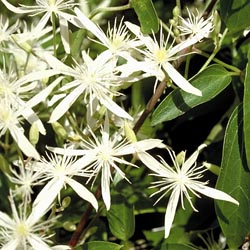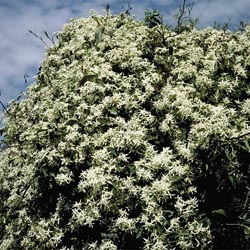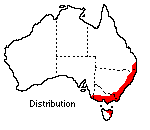Clematis aristata
 |
 |
Traveller's Joy, Goatsbeard, Old Man's Beard
Clematis aristata R.Br. ex Ker Gawl.
Clematis, a member of the Ranunculaceae (or buttercup) family , is a large genus of over 200 species, chiefly native to the temperate zones of the northern hemisphere. Six species are endemic to Australia.
Clematis aristata, sometimes called Traveller's Joy, Goatsbeard or Old Man's Beard (names also applied to northern hemisphere species), is a climber found in the coastal and tableland forests of the eastern states of Australia or on the edges of the eastern rainforests. It has been recorded in Western Australia, but there is doubt about the accuracy of this record.
 Flowering
in spring, the species is most attractive with its masses of creamy white flowers
borne on short branches in the axils of upper leaves. The flowers are 2-3cm
across and consist of four lanceolate petal-like sepals arranged in a star pattern.
They enclose numerous silky stamens or slender, plumed styles as the flowers
are usually either male or female. The styles on the female flowers persist
to form curved feathery appendages on the tightly clustered fruit. In this stage
the plant is very decorative and inspires two of the common names - Goatsbeard
or Old Man's Beard. Leaves are opposite, trifoliate with faintly but irregularly
toothed margins. Juvenile foliage is purplish with white or silver markings. (Look here
for a glossary of botanical terms)
Flowering
in spring, the species is most attractive with its masses of creamy white flowers
borne on short branches in the axils of upper leaves. The flowers are 2-3cm
across and consist of four lanceolate petal-like sepals arranged in a star pattern.
They enclose numerous silky stamens or slender, plumed styles as the flowers
are usually either male or female. The styles on the female flowers persist
to form curved feathery appendages on the tightly clustered fruit. In this stage
the plant is very decorative and inspires two of the common names - Goatsbeard
or Old Man's Beard. Leaves are opposite, trifoliate with faintly but irregularly
toothed margins. Juvenile foliage is purplish with white or silver markings. (Look here
for a glossary of botanical terms)
For best results C. aristata should be grown in a position with some overhead shade and in deep cool soil. Liberal mulching with leaf litter would be beneficial. It may be easily trained to cover an artificial support such as a fence, trellis or pergola but in nature uses a tree or bush for support. It may also be used as a ground cover in the absence of vertical elements.
Germination results are best from fresh seed sown in the summer. The species may also be propagated by striking semi-hardwood cuttings under glass in high humidity. Pruning is necessary to clear crowded growth to make way for new, more vigorous growth. Pests have not been noticed on this species.
Text by R. T. Jackson (1979)
Name meaning: Clematis aristataClematis - from the Greek, klematis, the name of a plant (Clematis vitalba), derived from klema, meaning a twig, perhaps because of the twiggy branches; aristata - from the Latin meaning bearded, an allusion to the bristle-like appendage of the fruit |
![An Australian Government Initiative [logo]](/images/austgovt_brown_90px.gif)

